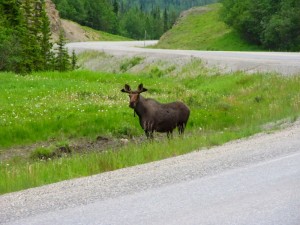
At the start of the tour. All photos courtesy of Chris Figureida.
Bike tourists often talk about metaphorical highs and lows. An amazing sunset over a breathtaking vista, an endless climb on an empty stomach; they’re the moments that help capture the essence of the ride in its retelling. When Chris Figureida tells the tale of his latest adventure, he has a very literal low and high to which he can point. The low: Death Valley, the start and end to his tour. The high: 17,200 feet up Mount McKinley, the highest peak in the United States and the halfway point for Figureida’s 5 month, 7,761 mile, round-trip bike tour.
According to Figureida, a half-dozen or so other cyclists have done the ride from Death Valley to Denali. He says he is the first to ride it round trip. The 31-year-old set out on this tour in large part to raise money for the American and Canadian Heart and Stroke Associations and Rotary International’s Polio Plus. He raised about $4,000 on the ride. But he also took on this journey to sate his strong sense of adventure as an avid mountaineer and bike tourist.
Figurida set off from Death Valley, California in March of this year. He rode through Nevada and Idaho, across Canada, and eventually up the desolate, icy Alaskan Highway to Denali National Park. The plan was to then ski 60 miles to the Mount McKinley base camp before summiting the peak.
Few of us would undertake a bike tour as arduous as Figurida’s. Even fewer would consider climbing a 20,327-foot mountain. But for Figurida, the trip was a natural progression after two decades of mountain climbing and seven years of increasingly difficult bike tours. When he was 13, an older cousin on leave from the Army showed him how to rock climb.
“My cousin was stationed in Northern Italy and had access to train and climb in the Dolomites,†said Figurida. “He came home, showed me basic techniques and helped me buy my first pair of climbing shoes.â€
The newfound interest quickly blossomed into obsession. “I started saving up for expensive gear and researching routes and techniques. I wanted more then just the top of the wall; I wanted the top of the mountain.â€
Like most high alpine climbers, Figureida quickly learned about the Seven Summits. It is a mountaineering challenge to climb the highest peak on all seven continents. Figurida climbed Tanzania’s Mount Kilimanjaro in 2006 and Argentina’s Mount Aconcagua in 2010. It was on that trip to Kilimanjaro that he was first inspired to raise money for charity.
After finishing the Kilimanjaro climb, Figureida took a side trip to Kenya where he met a group of volunteer HIV/AIDS hospice workers. It had a deep impact on him.
“It was amazing to meet people who had given up their friends, families, careers, and social positions to help others. I wanted to be like them. I wanted to be able to look myself in the mirror and say that I would also give the shirt off my back if someone asked.â€
Figureida returned to the States with a new goal to help people. Drawing on his experience touring by bike from Seattle to Mexico in 2005, he decided he would ride from his home in Ventura, California to Lubec, Maine. He raised money for heart disease charities and talked to children along the way about the benefits of being healthy and active. He went on to do four more cross country tours in the U.S. (not including the one he just completed) and one tour in Argentina. Through all that he’s spoken to an estimated 50,000 school children and raised funds and lobbied on behalf of the American Heart Association.
Despite his significant touring experience, Figureida found his latest trip uniquely difficult at times and uniquely amazing. The roads he was riding in northern Canada and Alaska were so remote that he often didn’t know where his next meal would come from, once to the point of completely running out of food. The Alaskan Highway is open seasonally, making it difficult for Figurida to find open stores as he rode through in the off season.

Frozen highway. Photos courtesy Chris Figureida.
“I’d ridden about 120 miles in northern British Columbia and there was absolutely nothing to eat. I got some food that night, but I’d given myself an ulcer riding that far on an empty stomach. The next day I called ahead to a store to see if they had food. It was an 80-mile ride with a 4,000-foot climb in the middle of the route to get there. When I got there the only food he had was six snack-sized bags of salt and vinegar chips and three liters of coca cola. That was 1,800 calories total.â€
If near-starvation weren’t enough, Figureida had a close encounter with timber wolves that night. As he lay in his tent he could hear the timber wolves howling, trying to corral elk near his tent. “It was so terrifying to hear that howl. It’s such a primal sound and it pulls out this instinct inside of you that drives the fear.â€
But, the remoteness of the highway provided some of the trip’s great moments as well. “I had the whole road to myself. I saw tons of animals: buffalo, goats, big horn sheep, moose, caribou elk.â€
Figureida eventually made it to Denali National Park and began his attempt at the 60-mile ski in to the McKinley base camp. But, after two months of daily pedaling, the shape of his foot had morphed enough to no longer fit well in his climbing boots. One day of skiing left his feet shredded with blisters. After turning around and resting up for five days, he flew in to base camp and to meet his team and attempt the climb.

Top of the world. Photos courtesy Chris Figureida.
The team spent 25 days trying to climb the mountain. They got stuck at 17,200 feet for eight days waiting out a big storm. The windchill brought temperatures down to -50 (Fahrenheit). The winds were blowing at a steady 30-60mph. At the end of the eight days, the team had a small break in the weather and had to either push on towards the summit or head back down the mountain. Running out of food and fuel, they decided to descend to camp.
Their decision turned out to be for the best. On their way down, they passed a team of Japanese climbers who were going to wait out the storm longer before descending. Four members of that five-man team were killed in an avalanche the next day.
Figureida started his return journey from the frozen mountain and was quickly met with the stark contrast of an Alaskan springtime.
“The whole world had turned a vivid, vivid green. The flowers were out and the bees and birds had returned. There were bears. It was amazing.â€
 The trip back was a significantly more social affair. Figureida had the opportunity to talk with RVers traveling the highway and share his mission with fellow campers in the evenings. He stopped in Edmonton after delivering money he raised to the Canadian Heart and Stroke association. As a thank you, the city of Edmonton invited him to ride their 30-seat, pedal-powered float in their annual Capital EX parade.
The trip back was a significantly more social affair. Figureida had the opportunity to talk with RVers traveling the highway and share his mission with fellow campers in the evenings. He stopped in Edmonton after delivering money he raised to the Canadian Heart and Stroke association. As a thank you, the city of Edmonton invited him to ride their 30-seat, pedal-powered float in their annual Capital EX parade.
The trip took a turn for the difficult once more before its end. As Figureida entered Death Valley the temperatures skyrocketed to 110, 115, then 117 as he reached Furnace Creek. On his final push to the finish in Badwater, the temperature hit 122. On the brink of heat exhaustion, it took him two hours to ride the last 17 miles.
Figureida completed the ride in late August. One month later, he’s already planning his next adventures; his next opportunities to raise money and reach out to children. His next ride will be across the southern tier of the United States from California to Jacksonville, Florida, stopping along the way to speak at schools and raise some money. After that, he’s got his eyes on a much larger adventure. He wants ride from the Caspian Sea to Mount Elbrus in Russia.
To keep up with Figureida’s adventures going forward, visit his blog at cycleforheart.org.



3 Responses to From Death Valley to Denali, Chris Figureida’s Ride for the Heart